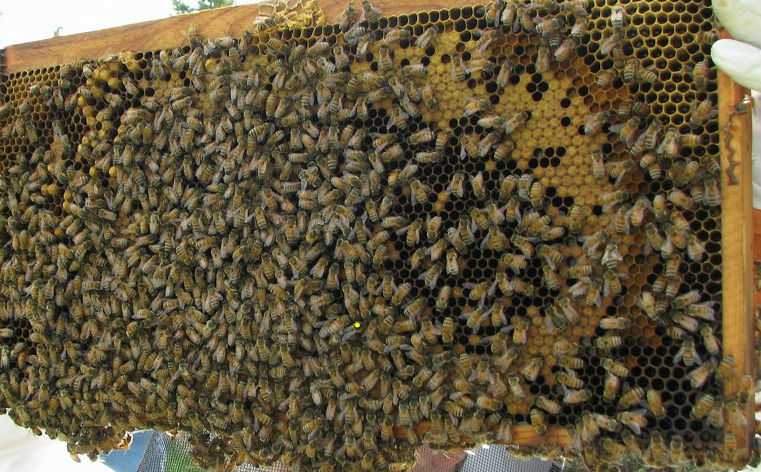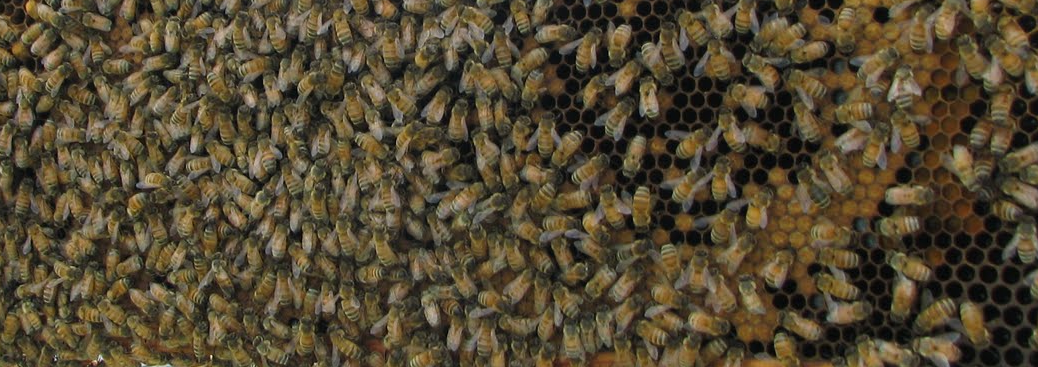Finding an unmarked queen is difficult enough so getting her marked early in the season is vital for what comes later. As an illustration of that – see if you can spot the queen in the photo above – experienced beekeepers hold your whist!
Scroll down to the bottom of the page for the same photo but with the queen marked.
-
How to Find Her
There is a knack to finding the queen and nothing but practice will allow you to master that. However there are things to do, things not to do and things to look for that will increase your chances.
Things to do and things not to do
- Go quietly and gently – avoid crushing bees. Apart from the alarm pheromone any one of them could be the queen!
- Blowing smoke into the entrance or under the crownboard will set the bees running;
- Use little smoke and only when you have to;
- Use a water spray to calm the bees instead;
- Choose a day as early in the season as possible, the longer you leave it, the more crowded the hive will become – needle and haystack time. However, do be aware that if you damage the queen before there are drones on the wing it will be difficult to replace her;
- Choose a day when the bees are flying freely – there will be fewer of them sitting at home waiting to ‘help’ you.
Now…
- Carefully remove the roof then quietly crack the crownboard – more difficult if the day is cold and propolis is brittle. Wait a minute for the bees to calm before lifting it.
- Check she isn’t on the crownboard then set it aside preferably on the upturned roof – just in case.
- Look down into the broodbox and locate the area where there are most bees – this is where the brood nest is and – as long as you’ve been gentle so far – this is where the queen will be.
- If the bees start to come up at you – spray them with water.
- Find a frame, away from the brood nest, which looks like it will come out easily and gently remove it without rolling bees. If it turns out to have a bulge and you are rolling bees put it back and choose another;
- Make your way as quickly and quietly as possible towards the broodnest examining each frame as you go;
- When you find the pollen frame you will know that the next frame will have brood and possibly the queen so keep your eyes peeled;
- Look out for eggs – she is often on this frame;
- Look for young and emerging brood – she is often on such a frame – laying into vacant cells as the brood hatches and the bees clean the cells;
- Watch also for a frame where the bees are very quiet – there will be a high concentration of calming queen substance close to the queen;
- When lifting the frames – look first on the ‘dark’ side of the frame; the queen will instinctively move away from the light. Imagine yourself into that frame lifting situation and apply brainpower here because – words fail me.
Things to look for…
- The queen has rather different legs to the other bees – they tend to be reddish and ‘spider-like’.
- She is of course bigger than the workers – but not that much.
- Her abdomen is longer and more pointed with a swollen look.
- She moves differently to the other bees
Marking the Queen
To mark the queen, you will need either nerves of steel or a crown of thorns to temporarily cage her.
Press it down carefully so her thorax is held within one of the squares of mesh in the cage and she is unable to move.
Do not squeeze her abdomen – that is the ‘business end’ of your queen; it is where she keeps the eggs and is very delicate and easily damaged so only press down on her thorax.
Dab a mark of the appropriate colour on her thorax then ease the cage up to let her stand up and walk about without smudging the paint on the mesh but keep her inside it for a couple of minutes while the paint dries. Click here for more on queen marking colours

Clipping the Queen
There are many ways to clip the queen and which method you choose depends on your confidence, your manual dexterity and the steadiness of your hand – in fact this will have to be the subject of a different post.
Copyright © Beespoke.info, 2015. All Rights Reserved.
